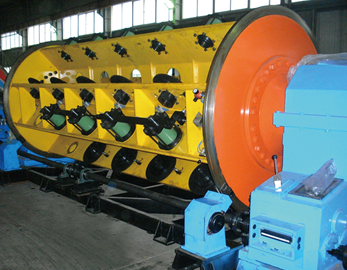What are the uses of Rigid Frame Stranders ?
 Apr 26, 2022|
Apr 26, 2022| View:506
View:506Stranding Equipment:
Today, putting a number of wires (bare or insulated) together into a cable has become a major part of the cable industry. A wide range of stranding and cabling machines are used for the production of all kinds of cables including fiber optic cables.
Following are only few of them:
Rigid Frame Stranders:
Rigid Frame Stranders are cage type machines without backtwist. The Multi-purpose rigid cage stranders are used to
Strand aluminum and copper wires to round, compressed, compact bare conductors;
Produce overhead power transmission cables, such as ACSR;
Strand Milliken conductors (Segmented conductors);
Screen power cables with copper wires;
Strand insulated conductors.
Typical lines include the capability to strand 37 or 61 elements in a single pass with tandemizing options to further enhance the line’s capabilities. Cages are available in various construction types with various spooling brake systems (spool brake with D.C. motor, electromagnetic brake and pneumatic brake and mechanical brake) and loading system (overhead loading and side loading)
Drum Twisters:
Drum Twisters can be used to cable round, compressed, compact and sector inctored insulated cores, strand Milliken conductors, apply steel wire armoring and screen to power cables etc. The components of a typical machine for producing Milliken cables which have copper cores made of segmental sections separated by paper tapes, are as follows: 1 portal type traversing pay-off stand, 5 rotating pay-offs, 4 filler stands fpr 80bobbins, 3 tape applicators for segmental, 1 pay-off for central filler, 1 rotating caterpillar, 1 rotating take-up, control system (PLC+Computer) and so on.
Milliken Conductors:
With alternating current there is a tendency for more of the current to be carried on the outside of the conductor than in the centre( skin effect), and to overcome this problem, the larger sizes of conductor are frequently of Milliken construction. Such conductors are formed from several individual sector shapes, usually four for power distribution cables and six for hollow-core fluid filled cables. A thin layer of paper or other suitable insulation is applied over alternate sectors. There is insufficient economic advantages to use this construction blow 900mm², but the Millken design may also be used to obtain increased conductor flexibility.
In the USA such conductors are often termed to be of segmental construction.
Laying up and taping such bare copper sector require a sophisticated machine (tension controls) and truly specialized know-how.









